
Imagine discovering a hidden world full of strange creatures and life right under our ocean’s floor!
That’s exactly what an international team of scientists did during a 30-day adventure at sea.
Where Did They Go?
Led by Dr. Monika Bright from the University of Vienna, the team set off on a ship named Falkor to explore an underwater volcano in the East Pacific Rise, near Central America.
With scientists from places like the United States, Germany, the Netherlands, France, Costa Rica, and Slovenia, this was a big deal.
What Did They Find?
Using a special underwater robot, they looked at chunks of the volcanic crust and discovered caves filled with life!
They found worms, snails, and unique bacteria living in warm water.
This new discovery shows that life around hydrothermal vents (a fancy term for underwater hot springs) isn’t just on the surface; it’s hiding below the floor of the ocean too!
A New Way to Travel?
Something else exciting happened. The scientists found evidence that some vent animals, like tubeworms, might be moving under the seafloor!
These creatures are important to life around hydrothermal vents, but scientists haven’t found many young ones above the vents before. Dr. Bright’s team thinks these tubeworms might be traveling beneath the Earth to find new places to live.
Dr. Bright said, “Two dynamic vent habitats exist. Vent animals above and below the surface thrive together in unison.” That means life above and below the ocean floor is connected and depends on things like vent fluid from below and oxygen from above.
How Did They Study This?
To learn more about how these animals might be moving, the team used the underwater robot to glue mesh boxes over cracks in the Earth’s crust.
They left them there for a few days. When they removed them, they found animals living in cavities below the surface near the hydrothermal vents.
The scientists will spend the next few months studying what they found, but this is already a massive discovery.
Why Is This Important?
Hydrothermal vents are like underwater geysers caused by movements in the Earth’s crust. When a new vent pops up, animals quickly move in, making it their home. But how they find these new homes has always been a mystery.
Now, thanks to Dr. Bright’s team, we know they might be traveling through the vent fluids under the ocean floor!
Dr. Jyotika Virmani, the Executive Director of the Schmidt Ocean Institute, said, “This truly remarkable discovery of a new ecosystem, hidden beneath another ecosystem, provides fresh evidence that life exists in incredible places.”
The discovery isn’t just exciting for scientists. An artist named Max Hooper Schneider was also part of the team. He made sculptures and filmed them with the underwater robot. He found the dark, hidden ecosystems of the deep ocean fascinating and plans to include his research in future art exhibits.
Wendy Schmidt, president of the Schmidt Ocean Institute, emphasized that these discoveries show how urgent it is to explore and protect our oceans. There’s so much we don’t know yet, and each discovery helps us understand more about our world.
Our ocean is full of surprises! This new discovery of a hidden world beneath hydrothermal vents adds another layer of mystery and excitement to our understanding of life under the sea.
Who knows what other wonders are waiting to be found in the deep, hidden corners of our planet?
Follow us on Twitter for more articles about this topic.
Source: Schmidt Ocean Institute.



